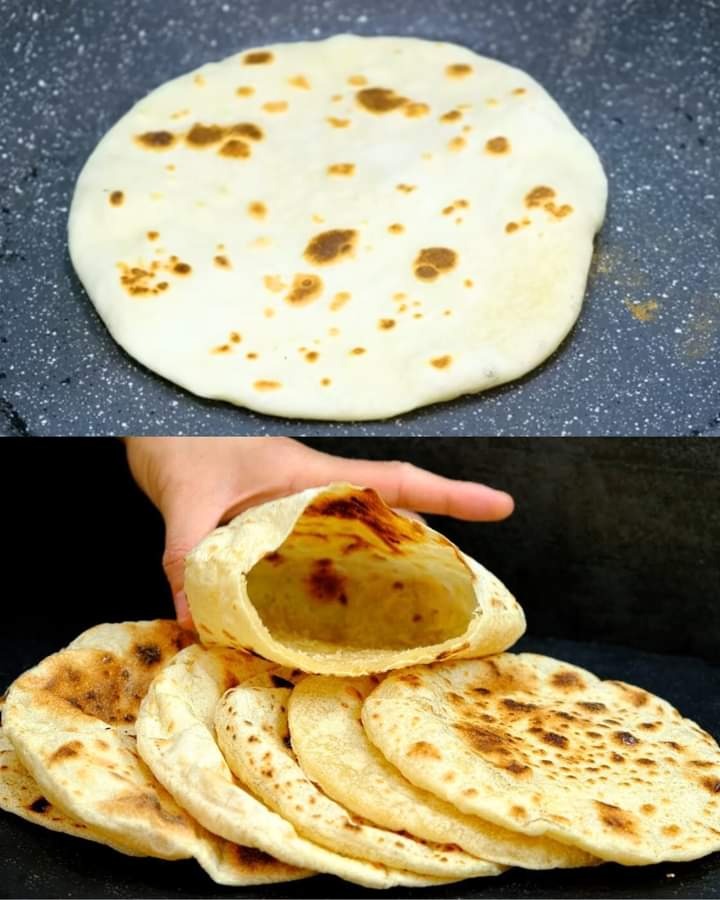ADVERTISEMENT
Instructions
Step 1: Proof the Yeast
Start by activating your yeast. In a small bowl, combine the warm water, sugar, and instant yeast. Stir gently and let it sit for about 5–10 minutes, until it becomes frothy. If the mixture doesn’t foam, your yeast may be expired or the water may have been too hot or too cold.
Step 2: Mix the Dough
In a large mixing bowl, combine the flour and salt. Create a well in the center and pour in the frothy yeast mixture, along with the olive oil (if using) and lemon juice or vinegar (optional). Stir the ingredients together until they form a dough. You can use a spoon or your hands for this.
Step 3: Knead the Dough
Once the dough begins to come together, transfer it to a lightly floured surface and knead for about 5–7 minutes. The dough should be smooth and elastic. If it’s too sticky, add a bit more flour; if it’s too dry, add a little more water—just a teaspoon at a time. If you prefer, you can use a stand mixer with a dough hook attachment to knead the dough.
Step 4: Let the Dough Rise
Once kneaded, place the dough in a lightly oiled bowl and cover it with a clean kitchen towel or plastic wrap. Let it rise in a warm place for about 1 to 1.5 hours, or until it doubles in size. You can speed up this process by placing the bowl in a slightly warm oven (turn the oven on for a few seconds and then turn it off) or on top of the refrigerator.
Step 5: Shape the Pitas
Once the dough has doubled in size, punch it down gently to release the air. Transfer the dough to a floured surface and divide it into 8 equal pieces. Roll each piece into a smooth ball and then use a rolling pin to flatten each ball into a circle about 6–7 inches in diameter. Try to keep the thickness uniform.
Step 6: Preheat the Oven (or Skillet)
If you’re using an oven, place a baking stone, inverted baking sheet, or pizza stone in the oven and preheat it to 475°F (245°C). If you’re using a stovetop, preheat a heavy skillet or cast-iron pan over medium-high heat.
Step 7: Bake or Cook the Pitas
If baking in the oven, place each rolled-out pita on the preheated baking stone or sheet. Bake for 2–3 minutes or until the pitas puff up and become lightly golden. You’ll know they’re done when they’ve puffed up into a nice pocket. If they don’t puff fully, don’t worry—sometimes it takes a little practice to get the perfect puff!
If cooking on the stovetop, place each pita onto the preheated skillet. Cook for about 1-2 minutes on the first side until you see bubbles forming. Flip and cook the other side for about 1 minute. The pita should puff up as it cooks.
Step 8: Cool and Serve
Once baked or cooked, remove the pita from the oven or skillet and wrap them in a clean kitchen towel to keep them warm and soft. Allow the pitas to cool slightly before serving. They’re best enjoyed fresh but can also be stored in an airtight container for a few days or frozen for later use.
Tips for Perfect Homemade Pita Bread
- Make Sure Your Oven Is Hot: Preheating your oven (or skillet) properly is crucial to getting the perfect puff. A very hot cooking surface helps the pitas expand quickly and form the classic pocket.
- Rolling the Dough Evenly: For the pitas to puff properly, try to roll the dough as evenly as possible. If there are uneven areas, the pita may not puff up as nicely.
- Don’t Open the Oven Too Early: If you’re baking in the oven, resist the urge to open the door too soon, as the drop in temperature can affect the puffing process. Wait until the pitas have fully puffed before checking.
- Use Whole Wheat Flour: If you prefer a healthier version of pita bread, swap half or all of the all-purpose flour for whole wheat flour. It will give the pitas a nuttier flavor and extra fiber.
- Stuffing Ideas: Once your pita bread is ready, stuff it with anything you like! Try falafel, grilled vegetables, chicken shawarma, hummus, tzatziki, or any of your favorite Middle Eastern or Mediterranean fillings.
Conclusion
Making homemade pita bread is a fun and rewarding process that results in soft, fluffy, and delicious bread that’s perfect for a variety of dishes. Whether you’re using it for a Mediterranean-inspired meal or just enjoying it with olive oil and herbs, homemade pita is a great addition to any kitchen. With this simple recipe, you’ll have fresh pita bread that rivals anything you can buy in the store—so grab your ingredients and get baking!
ADVERTISEMENT
